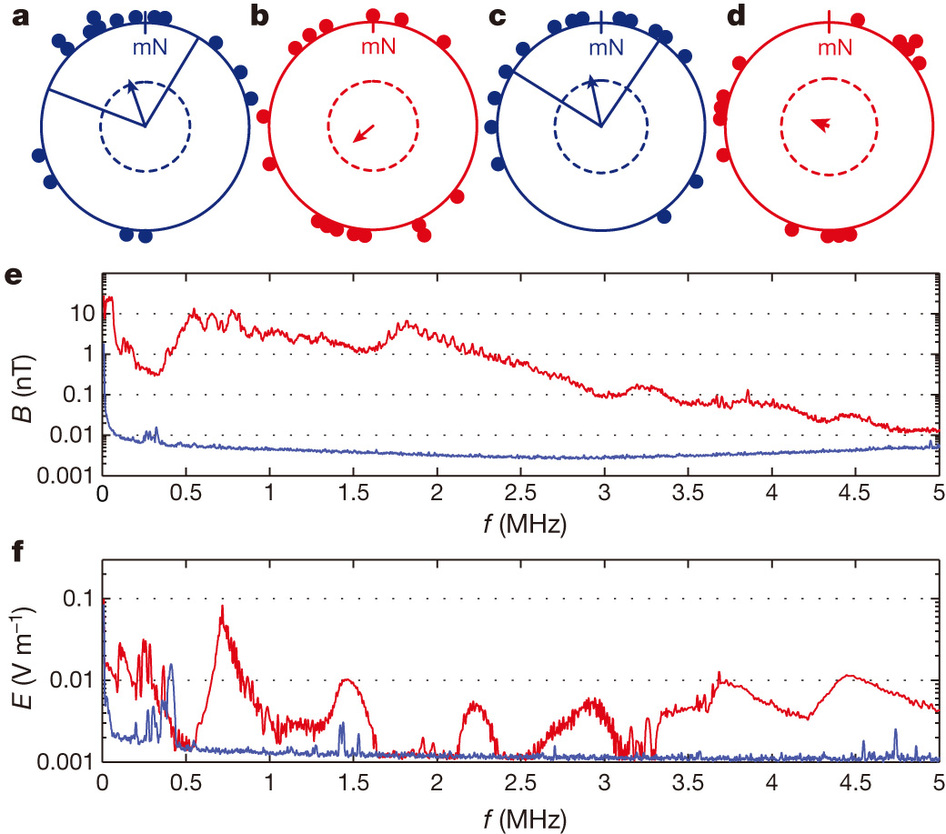Interesting piece in Nature:
Interference from electronics and AM radio signals can disrupt the internal magnetic compasses of migratory birds, researchers report today in Nature1. The work raises the possibility that cities have significant effects on bird migration patterns.
That’s from a news item. The actual paper is here (possibly paywalled).
There’s strong evidence that some animals (birds, sharks, and bacteria, among others) respond to the Earth’s magnetic field, but the mechanisms by which they sense the field are still quite uncertain in many cases. Physics Today did a nice overview of this about six years ago. I think it’s fascinating that such a simple question remains unsolved.
The new result appears to be that robins do poorly at orienting themselves to Earth’s magnetic field when they’re in an environment with human-generated radio frequency electromagnetic fields, but when you shield them from those fields, they get better. Here’s a figure from the paper:
The dots around the two blue circles show the way the birds oriented themselves when they were inside of a grounded metal shield. The two red circles show what happened when the shield was not grounded. In each case, the arrow at the center is the average of all the directions, and the dashed circle shows the threshold for a significant deviation from random (5% significance, I believe). The graphs below are the field strengths with and without grounding, as functions of frequency.
These results barely exceed the 5% threshold, but the paper gives results of other similar experiments that show the same pattern.
Although the experiment seems to have been well-designed, I have to admit I’m skeptical, for a familiar reason: you should never believe an experiment until it’s been confirmed by a theory. I find it hard to imagine a mechanism for birds to sense magnetic fields that would be disrupted by the weak, low-frequency fields involved here.
The authors acknowledge this:
Any report of an effect of low-frequency electromagnetic fields on a biological system should be subjected to particular scrutiny for at least three reasons. First, such claims in the past have often proved difficult to reproduce. Second, animal studies are commonly used to evaluate human health risks and have contributed to guidelines for human exposures. Third, “seemingly implausible effects require stronger proof”.
Here’s what they say about mechanisms:
The biophysical mechanism that would allow such extraordinarily weak, broadband electromagnetic noise to affect a biological system is far from clear. The energies involved are tiny compared to the thermal energy, kBT, but the effects might be explained if hyperfine interactions in light-induced radical pairs or large clusters of iron-containing particles are involved.
The “tiny compared to the thermal energy” part is the really puzzling thing. If these electromagnetic fields are having an effect inside the system, they must do it by something absorbing photons (since that’s all an electromagnetic field is). But the energy of a photon at these frequencies is tiny in comparison to the thermal energy sloshing around a biological system anyway, so how could there be an effect?
The first of these two mechanisms seems to refer to one of the proposed mechanisms for magnetoreception in birds, which Wikipedia describes as follows:
According to one model, cryptochrome, when exposed to blue light, becomes activated to form a pair of two radicals (molecules with a single unpaired electron) where the spins of the two unpaired electrons are correlated. The surrounding magnetic field affects the kind of this correlation (parallel or anti-parallel), and this in turn affects the length of time cryptochrome stays in its activated state.
I think that this mechanism involves tiny energy differences between quantum states of a system, depending on how the electron spins are oriented. If the energy differences are tiny enough, then I guess low-frequency EM fields could disrupt the effect. But if the energy differences are that small, then I don’t understand why normal thermal fluctuations don’t mess it up all the time. I guess that for this mechanism to work, the electrons have to be shielded from thermal fluctuations, but external EM fields could still sneak in and mess them up. I guess that might be possible, but I’d want to see the details.
I completely don’t get what the authors are talking about when they refer to “large clusters of iron-containing particles”. I can’t see any conceivable way such particles could be affected by weak oscillating fields of the sort described here.
I have no idea whether you should believe this result or not. I hope that others will attempt to replicate it. If it’s real, it’s got to be a big clue about the interesting puzzle of how birds feel magnetic fields.

“Here’s a figure from the paper”
Let’s just call them the round-robin diagrams! 🙂
“animals (birds, sharks, and bacteria”
Bacteria are not animals. 😐
I completely don’t get what the authors are talking about when they refer to “large clusters of iron-containing particles”.
Neither do I. However, there are such things in some animals and they are involved in sensing magnetic fields. Maybe, due to ferromagnetic effects, such larger structures are more stable with respect to disturbances.
.
I would think so — that is, I would think that iron clusters would be insensitive to disturbances to do low-level RF interference. The puzzling thing is that that sentence, if I understand it correctly, suggests the opposite.
Thanks for pointing out the “bacteria” error, by the way.
Oh, and I’d be remiss if I didn’t congratulate you on a world-class pun.